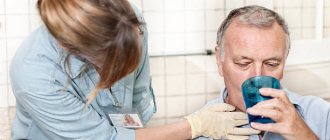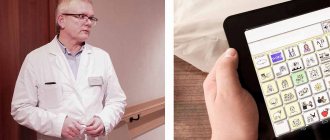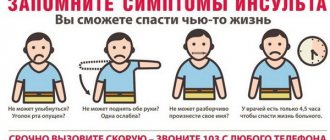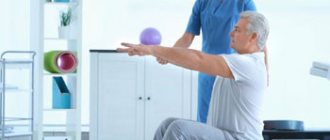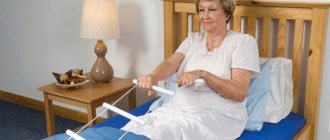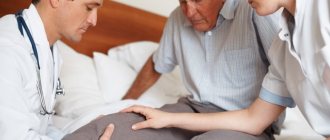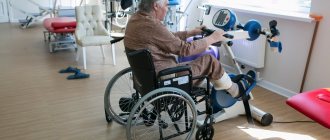Unfortunately, in our time, strokes occur too often. Modern medicine has effective treatment methods that save people from death. But what to do then, after salvation? Life after a stroke changes in significant ways. Some people remain disabled until the end of their days, while others make attempts to restore lost functions. This mainly refers to disturbances in movement, memory, and speech. If a small area of the brain is damaged, a person returns to normal life faster; significant improvements can be observed after a few weeks. In any case, a lot of effort must be made to ensure that the rehabilitation period is effective. It is important to adhere to the main principle: never give up and systematically train your speech and body. In this case, it is not necessary to be in hospital treatment. All workouts can be done at home. Moreover, houses and walls help.
According to statistics, 5-6% of people who have had a stroke need constant care. But everyone has a chance for a quick and full recovery.
Why don’t people want to recover after a stroke?
The success of rehabilitation depends on the patient’s mood. People who have had a stroke may seem indifferent to their health. Very often they become irritable, aggressive, and whiny. They follow the doctor’s recommendations without much desire and prefer to lie down and watch TV. But with this approach there is no hope for a quick recovery. Relatives and friends need to muster all their will in order to successfully overcome the consequences of the disease. For some, it is enough to understand that the patient’s whims are not the result of laziness or bad character, but a consequence of damage to certain areas of the brain. Therefore, the primary task of loved ones is to help patients overcome their reluctance to exercise.
The rehabilitation period can last a long time, so both the patient and his family need to be patient. The effectiveness of the procedures depends on their systematicity and high-quality implementation.
Stroke: how to live on?
Stroke affects people in different ways. Some will be able to completely restore lost functions, while others will remain disabled. Some will need help from loved ones for the rest of their lives, while others will need help only occasionally, for example when walking up the stairs. In any case, every patient after a stroke must go through a recovery path. An expert will help us understand the topic.
— How does a stroke begin? What are the main symptoms?
— Patients often feel the onset of a stroke as numbness and tingling in half of the face, arms and legs. If a stroke affects the areas of the brain responsible for speech function, the patient rearranges syllables and letters or pronounces only individual sounds. There may be disturbances in movement, dizziness (with a stroke, it is accompanied by a clear sensation of the movement of all surrounding objects around the patient). There may be visual disturbances - double vision, loss of certain parts of the visual field - blind spots.
— What household habits lead to a stroke?
— Smoking increases the risk by 60%, and quitting smoking significantly reduces it in a short time. And with complete abstinence for 5 years, the risk of stroke in a former smoker is reduced to the level of a non-smoker. People who are overweight and sedentary should be careful (physical inactivity is a risk factor for heart and vascular diseases). Do not abuse alcohol, salty foods and animal fats.
— What is a microstroke? Warning?
— Although we hear this term quite often, it does not exist in medicine. There is a concept of “minor stroke” - when all symptoms disappear within the first 3 weeks after the initial manifestations of cerebrovascular accident. As for warnings, if you experience any of the symptoms of a stroke, seek immediate medical attention. You can’t wait for it to pass on its own or for morning to come.
Important: medical care is most effective in the first 3-6 hours!
— Is it possible to fully recover after a stroke?
— With timely and complete rehabilitation, it is possible to ensure that up to 95% of patients do not require constant care. The most effective restoration of movement occurs within 3-6 months, household and work adaptation - up to 12 months, speech - within 2-3 years. Approximately up to 20-40% of patients can return to their previous work activities.
Stroke (from Latin insulto - I jump, jump), “brain stroke” is a group of diseases caused by acute vascular pathology of the brain, characterized by a sudden disappearance or disruption of brain functions.
There are:
— ischemic stroke (cerebral infarction) — the disease develops as a result of an acute disruption of blood flow to a certain part of the brain (up to 80% of all cases).
- hemorrhagic stroke (intracerebral hematoma) - brain pathology is caused by blood soaking an area of the brain (about 10% of all cases).
- subarachnoid hemorrhages - occur when the vessels of the meninges rupture (about 5% of all cases).
The cause of the remaining 5% of strokes remains unclear.
Advice for the patient's relatives
Occupational Therapy
Involve patients in household chores, not allowing them to sit for hours in front of the TV and immerse themselves in emotions. Restoring fine motor skills can be done under the guise of household chores: sorting buckwheat, peeling berries from seeds... The patient has to learn most of the simplest life skills again: fastening buttons, tying shoelaces, lighting the burners on the stove.
Speech training
Here you need the help of a speech therapist. And relatives should speak more slowly than usual, use simple words and phrases, accompany them with gestures and even drawings. Involve the sick person in conversation. If he cannot name the objects, try to use their names in your speech.
Improved attention
Use games that train your memory. Place objects on the table, then cover them and ask them to remember what was there. At first, avoid complex mind games. Ask what happened during the day.
Check
Coins help you learn to count again. If possible, go to the store together. Depending on the level of understanding, analyze a simple count. It is useful to play dominoes and lotto.
Time
Help the patient set the clock, remind him of the time to eat and wake up, use a calendar. Name the months, remember important dates.
Writing and drawing
Play games like tic-tac-toe, draw. Put a date on each piece. This will allow you to monitor your progress. Discuss colors and shades, select objects by color. Give tasks aimed at determining the shape of an object. Write holiday cards together.
Pets
According to statistics, pet owners have lower blood pressure and cholesterol levels, which reduces the likelihood of heart attack and stroke. And all because communication with animals relieves stress.
Neuropathologist Victoria Chkheidze, employee of the Artmedica center for medical innovations, Moscow
When caring for a patient, do not forget about yourself!
"If you're almost at your limit, stop and rest." Many relatives of the patient neglect this simple rule until fatigue knocks them off their feet. But weekends significantly increase the efficiency of any activity. Take your mind off painful thoughts. Do not lose the ability to enjoy the little things in life: the taste of food, the view from the window, the sounds of your favorite music. Go out and visit - it will help you hold on. Don't neglect traditional ways to relieve stress: walking, water treatments, sports, taking soothing herbal remedies and listening to music for relaxation. Knitting and fingering rosaries soothe.
How to feed a patient correctly
It is necessary to create the most comfortable position for the patient in bed, close to the natural position of eating and drinking. And follow the rules:
do not leave the patient alone when he eats; put food into the mouth from the side, on the undamaged side, otherwise he will not be able to feel the food and it will accumulate behind the cheek; encourage the patient to chew thoroughly and slowly; Make sure he concentrates on eating, eliminate distractions (TV, radio); make sure that the patient does not tilt his head down when chewing; keep his head elevated while eating and for half an hour after.
Therapist Dmitry Kubrakov, Moscow
What to eat after a stroke?
Eat foods that help restore nerve tissue - these are vegetables, fruits, milk and dairy products. To build new tissue to replace dead tissue, you need protein. It is found in fish.
Once a week you can even eat fatty varieties: salmon, salmon. Watch your intestines - there is no need for you to push, it increases intracranial pressure: eat bran. Magnesium and potassium will also help with recovery. There are a lot of them in dried fruits, in butter (5 g of butter per day).
Menu for one day
Breakfast: 2 egg white omelette or oatmeal, tea or coffee with milk. 2nd breakfast: boiled beef stroganoff, cottage cheese, apple or rose hip decoction. Lunch: vegetarian soup, boiled meat with vegetables, apple compote. Dinner: boiled fish with mashed potatoes, pilaf with fruit, tea with milk. At night: a glass of yogurt or prunes.
Nutritionist Marina Kopytko, Moscow
My uncle suffered a stroke. In addition to this, severe depression hit him. I treated him with massage, contrast shower and exercises. And also horse chestnut and sophora. Sophora thick-fruited restores movement in the limbs, normalizes sleep, and reduces blood pressure. Relieves spasms of peripheral blood vessels and improves blood circulation. Chestnut resolves blood clots, relieves shortness of breath and depression.
My uncle had to work hard for his recovery. But now he is already a strong, strong man. I went to work. They even removed his disability group and declared him healthy!
Paramedic Antonina Vasilyevna Momotova, Stavropol region, Predgorny district, st. Essentuki
Expert
Indeed, to reduce cerebral edema, it is recommended to take horse chestnut tincture 3 times a day, 1 tsp. It increases the elasticity of blood vessels, reduces blood viscosity, and horse chestnut herbal remedies themselves reduce blood clotting, prevent the formation of blood clots in blood vessels, strengthen their walls, and resolve blood clots. Sophora thick-fruited contains a complex of biologically active substances (flavonoids rutin and quercetin) that strengthen the walls of blood vessels. In China, this plant was used to combat bleeding and prevent strokes. Sophora contains pachycarpine, which is used to stop crises in hypertension. However, it is not recommended to prescribe Sophora for a long time, since pachycarpine is contraindicated during pregnancy, severe dysfunction of the liver, kidneys, and cardiovascular system.
Expert: Nailya Nasybullina, Doctor of Pharmacological Sciences
Authors: Drozhzha Kristina / Kubrakov Dmitry / Zueva Alexandra
Source: Health in building No. 25, November 10, 2009
Rehabilitation program and its features
Recovery after a stroke is facilitated by a whole range of different activities:
- professional massage and special physical education;
- work to restore memory and speech;
- psychological and social assistance;
- prevention of possible complications that occur after a stroke.
According to the recommendations of doctors, the patient should be treated 1-2 times a day, provided he is in good health. To perform certain physical exercises and exercises aimed at restoring memory and speech, 35-40 minutes of exercise is sufficient. What to do if a person feels weak, has shortness of breath, dizziness, or high blood pressure? You don't have to give up classes altogether. It is enough to reduce them to 10-15 minutes.
Try to add variety to your workouts more often. If the patient is already getting up and moving around, encourage him to walk on grass, sand, stones and other uneven surfaces. After a while, you can move on to climbing a hill or even climbing stairs. The main thing is not to rush things. For walking, you should choose orthopedic shoes or high boots, in which the foot is well supported.
Every day, teach your loved one something new: hold a spoon, fasten a zipper, put on shoes, turn a faucet on and off, answer a phone call, and so on. It is very important to help him. But you shouldn't try to do the work for him if you don't want to interfere with the recovery process.
Important point! The rehabilitation period should take place in a calm atmosphere. Therefore, be patient and do not get nervous when a person tries to do something on their own. Spilled water? Broke a plate? No problem, solve the problem with a smile and continue learning. It is vital for people who have suffered a stroke to feel needed. Therefore, you can safely involve them in doing simple housework.
Features of motor function recovery after stroke
Movement disorders are rightfully considered one of the terrible consequences of a stroke. They are expressed in partial or complete immobilization of the legs and arms.
Among the main methods used to restore motor functions are:
- electrical stimulation is a physiotherapeutic method based on the effect of pulsed electric current on the body;
- therapeutic physical culture (physical therapy);
- massage;
- biofeedback is a method, the essence of which is to “return” the values of physiological indicators to patients (information is displayed on a computer screen).
The ideal solution is to combine several methods. With any approach, there is no need to tire the patient with lengthy procedures or intense training. The load should be increased gradually.
A little remodeling of the apartment wouldn't hurt. Specially equipped handrails, as well as chairs for support, will make life easier for the patient.
Features of behavioral disorders after stroke
After a stroke, various disturbances in the patient’s behavior can be observed. The most common are the following:
Emotional instability . Over a short period of time, the patient's mood can change several times from irritability and even aggression to a serene state or fun. He may get angry over a trifle - an incorrectly adjusted pillow, a curtain that is not drawn tightly, etc.
Emotional lability . In this case, the patient is apathetic, indifferent to both his own condition and those around him. It is very difficult to persuade him to do gymnastics, give him a massage, invite him to communicate or feed him.
Hypersensitivity . The patient becomes overly sensitive, tearful, capable of being offended over trifles and retains the offended state for a very long time. He often reproaches his relatives for lack of attention and communication, tasteless food or unpleasant sensations during procedures, and accuses them of deliberately causing him pain.
Depression . People who, before the stroke, led an active lifestyle and had varied interests and hobbies, are most prone to depression. A state of prolonged immobility causes them to become gloomy and depressed, and with prolonged depression, the patient often has thoughts of suicide. This is manifested in his behavior - he can ask his relatives to “ease his suffering”; when accessing the Internet, he can look for methods of suicide, find out information about euthanasia, etc.
Psychomotor disorders . In a state of strong excitement, the patient may begin to throw things that are within his reach. At the same time, he can shout, use foul language, and is not afraid to harm those who are nearby.
The listed disorders are greatly complicated by a lack of physical activity and sleep disturbances - circumstances that negatively affect the psychological state of even a healthy person.
Write to WhatsApp
COST OF TREATMENT
How to cope with behavioral disorders in a patient
The patient’s relatives should first of all understand that this is the same person they loved and love. He hasn't changed, he'll just need a different attitude for some time. To make this time pass as quickly and comfortably as possible for both parties, listen to the following recommendations.
- Strictly follow all your doctor's instructions. Each point of therapy - from passive gymnastics to massage and hygiene procedures - is aimed at restoring certain body functions. When the patient tries to resist, do not give up, but always act softly and delicately. If the patient shows signs of severe agitation during treatment, postpone it for 1-2 hours and return to it when the patient calms down. If this behavior is repeated constantly, consult your doctor; he may consider it advisable to prescribe sedatives to the patient.
- Give the patient enough attention. Try to spend most of your time with him when he is awake. You can read a newspaper aloud to him, listen to an audiobook together, just talk - focus on how much the patient’s cognitive abilities are preserved and how much he enjoys certain activities.
- Do not be offended by the patient, even when he does not behave the way you want. Remember that brain dysfunction is a kind of computer breakdown. And it is natural that a person is simply not able to carry out some “programs” correctly.
- If it is psychologically difficult for you to care for a patient with severe behavioral disorders, it is advisable to use the help of a visiting nurse. Being in an unbalanced state, you will not help your loved one in any way and at the same time you will undermine your peace of mind.

